Index
- OCZ Trion 150 480GB SSD Reviewed
- Performance Specifications
- Packaging
- Testing Methodology
- Benchmark Results - CrystalDiskMark x64 v5.1.2
- Benchmark Results - ATTO Disk Benchmark v3.05
- Benchmark Results – Iometer v1.1.0
- Benchmark Results – AS SSD Benchmark v.1.8.5636.37293
- Benchmark Results – PlayStation 4 SSD vs HDD
- Price-per-Gigabyte Comparison (March 28, 2016)
- Conclusion
- All Pages
15nm TLC NAND offers better sustained reads, writes over 19nm
At this year’s CES in Las Vegas, OCZ introduced us to its new lineup of solid state storage devices for both consumer and enterprise customers, focusing its efforts mostly on its inclusion of Toshiba's latest 15-nanometer TLC NAND technology as the successor to its previous Advanced 19-nanometer (A19nm) TLC NAND flash.
Introduction
With its transition to new 15-nanometer triple-level cell (TLC) process technology, OCZ says customers can expect lower energy consumption over its previous Advanced 19-nanometer TLC NAND products, lower operating temperatures and noticeable improvements in sustained read and write performance.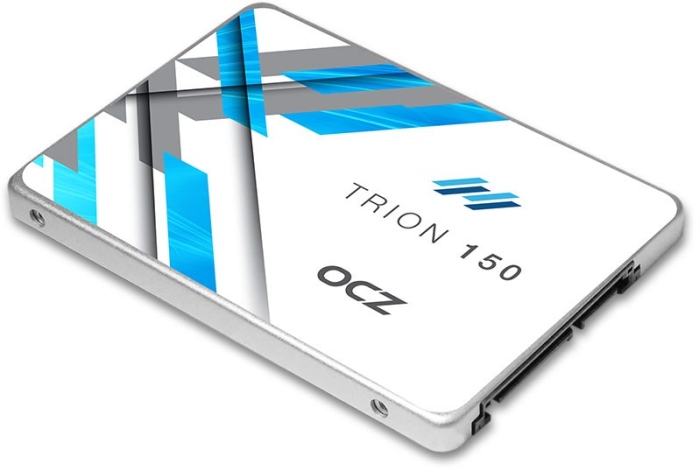
Back in December 2013 following OCZ’s bankruptcy filing, Toshiba acquired the company’s assets for $35 million, including OCZ’s previous purchase of South Korean-based Indilinx SSD controller subsidiary. Over the past two years, the company has been transitioning to using only Toshiba-owned technology, including controllers and NAND flash. With the introduction of the Trion 100 series in August 2015, OCZ is now producing solid state disks using 100 percent of Toshiba IP, even though the consumer SSD lineup features the OCZ brand name.
Fast forward a year and a half, and the company is now ready to give consumers its second-generation Trion series, complete with Toshiba NAND flash, a Toshiba controller, Toshiba cache and even Toshiba firmware. Just like last year’s Trion 100 series, OCZ is advertising virtually the same product specifications – 550MB/s maximum sequential read speeds, 530MB/s maximum sequential write speeds, 90,000 IOPS maximum 4K random reads (QD32), 54,000 IOPS maximum 4K random writes (QD32), and 3,200 IOPS steady-state 4K random writes (QD32). However, the big difference this time is hidden in a performance metric not shown on paper which we will test in the following pages – sustained sequential read and write performance.
OCZ Trion 150 series drives feature a 1.5 million hour MTBF and are fully compliant with SATA 3.1, Native Command Queuing (NCQ), SMART, idle time garbage collection and TRIM commands in supported operating systems. The drives use the same Toshiba TC58 controller as their Trion 100 predecessors, but instead of using Toshiba’s Advanced 19-nanometer TLC NAND, they now use Toshiba’s newer 15-nanometer TLC NAND technology.
As such, OCZ is calling its Trion 150 drives the “ultimate HDD replacement.” So in addition to our standard PC testing, we thought there would be no better way to test this statement than by placing the drive inside a PlayStation 4 and comparing game startup and level-loading performance among a variety of titles with the standard 500GB HGST Travelstar 5400RPM SATA II HDD included with the console.
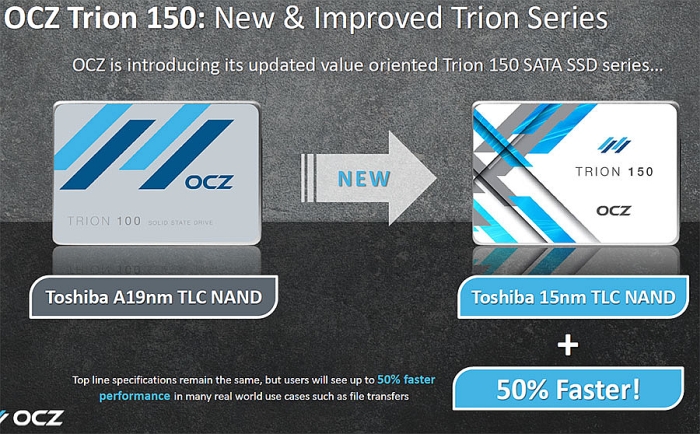
Trion 150 Series – Performance Specifications
The 480GB drive we are testing features a maximum random read of 90,000 IOPS (4KB, QD32), maximum random write of 54,000 IOPS (4KB, QD32), steady-state random write of 3,200 IOPS (4KB, QD32) and endurance rating of 120TB at 110GB/day.
Here are the new OCZ Trion 150 specifications from February 2016, based on Toshiba 15nm NAND flash. The new drives come in storage capacities ranging between 120GB and 960GB and are rated between 30TB and 240TB of total disk writes over a 3-year warranty period.
Trion 150 Series – Environmental Specifications
Power specifications remain unchanged for the Trion 150 series from the previous Trion 100 lineup. OCZ is rating idle power consumption at just 830 milliwatts (mW), active power consumption at 4.8 watts (W) and DevSlp power at 6 milliwatts (mW).
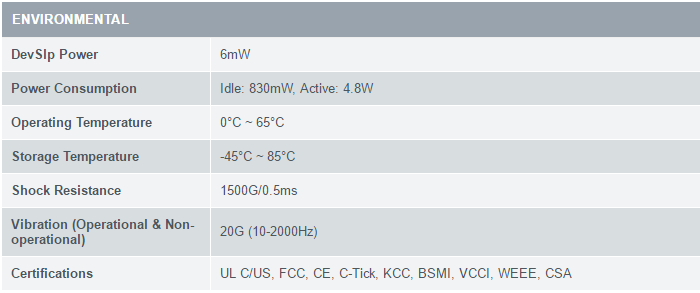
DevSleep is a feature in some SATA devices that allows them to enter a low-power “device sleep” mode while remaining powered on, reducing overall power consumption by at least two orders of magnitude over normal idle power draw (e.g. from 830mW to just 6mW in this case, although some drives can get as low as 2.5mW).
Trion 100 Series – Performance Specifications
Here are the OCZ Trion 100 specifications from July 2015, based on Toshiba Advanced 19nm NAND flash. The first-generation Trion drives also came in storage capacities ranging between 120GB and 960GB and are rated between 30TB and 240TB of total disk writes over a 3-year warranty period.

Trion 100 Series – Environmental Specifications
(same as Trion 150 Series)
Hardware specifications very similar – what’s new here?
Despite the new Trion 150 series having nearly identical specs with its predecessor, OCZ’s press release states, “as the next iteration of this series, expect improved sustained performance and enhanced file transfer rates.” From the company’s official presentation slide, it is claiming up to 50 percent faster real-world performance for file transfers with its 15-nanometer TLC NAND flash over the previous Advanced 19-nanometer (A19nm) 128Gbit TLC NAND technology.
Although there is a difference in NAND flash, it appears that both lineups use the same Toshiba controller under the hood, with the newer Trion 150 lineup using a more improved firmware. The previous Trion 100 series uses a Toshiba TC58 controller and Toshiba firmware. After some investigative digging, AnandTech is claiming the Trion 100’s TC58 was based on Phison’s S10 controller because of a very similar PCB layout. One reason to support this claim is that Toshiba and Phison have had a close manufacturing relationship for years, with Toshiba having partial access to Phison’s firmware source code and Phison’s OEM drives being manufactured in Toshiba’s own factories.
In addition to utilizing Toshiba's latest 15-nanometer NAND flash, the newer Trion 150 series uses the same Toshiba TC58 controller, but now has a newer firmware. The sample we were provided came with firmware version 12.2, and this is the initial release for the Trion 150 series according to OCZ’s website.
This is the premise we are going to run with during this review.
The unit we received came packaged in a traditional OCZ retail SSD box showing the product image and storage capacity on the front and specifications on the back.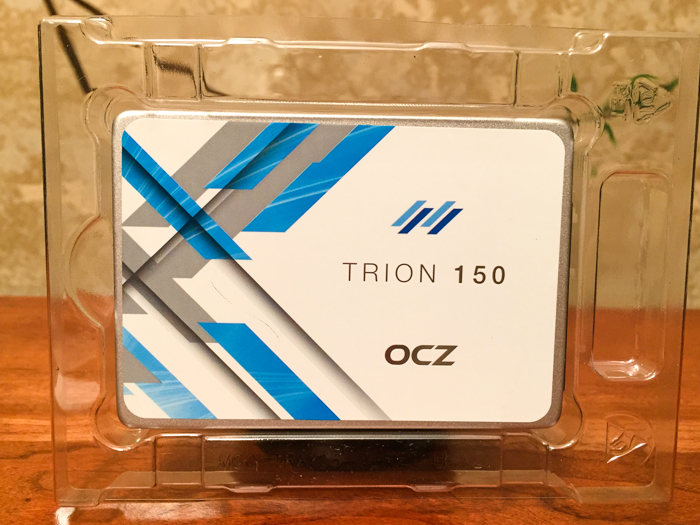
OCZ Trion 150 480GB (TRN150-25SAT3-480G)
OCZ Trion 150 packaging and user manual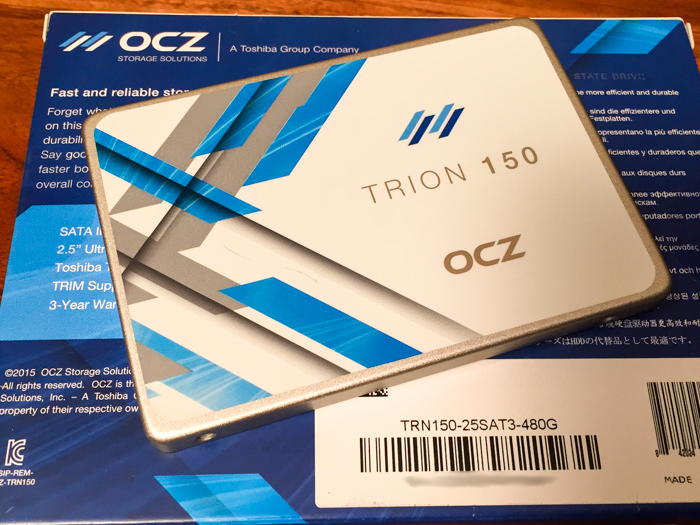
(We were a bit amused that the product packaging still says 2015 as the copyright date.)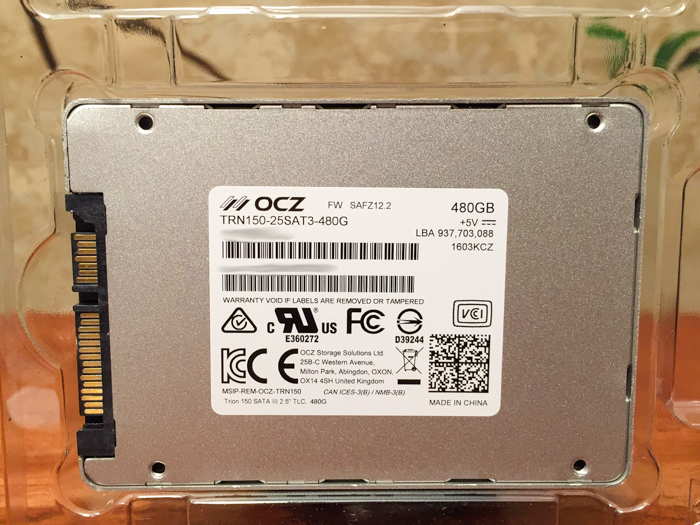
OCZ Trion 150 480GB (TRN150-25SAT3-480G)
OCZ Trion 150 drives have about 6.25 percent of their NAND capacity over-provisioned. This extra space is usually reserved for wear-leveling and some other proprietary features that improve drive endurance ratings, all of which are backed under a 3-year warranty.
The drive itself features anodized aluminum housing just like its predecessor and does not feature any screws, making it particularly difficult to remove the casing and take a look under the hood. We tried prying up the sides with tweezers and a small flathead screwdriver but were hesitant that the housing might become damaged with too much force.
Nevertheless, the folks over at HotHardware and some other review sites were able to successfully pry open the Trion 150 housing without damaging the aluminum frame, and below are two images of the underlying printed circuit board from their findings.

Image credit: HotHardware.com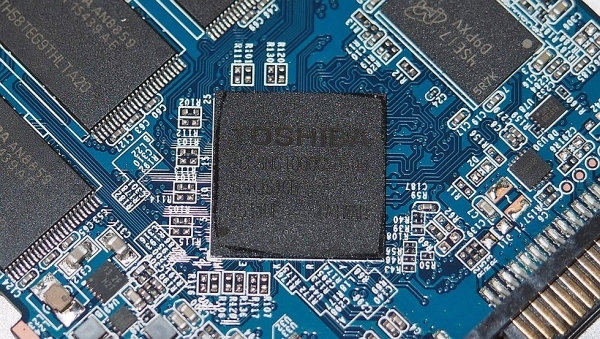
Image credit: HotHardware.com
The PCB reveals sixteen 32Gb Toshiba 15-nanometer NAND flash modules and a Micron DDR3 DRAM cache chip for the 480GB model. Based on some other review samples, including the 240GB unit Guru3D received, the DDR3 memory cache chip can be from either Micron or Nanya, and some surface mount traces show that a second DDR3 cache chip can be installed for the larger 960GB model.
The drive conforms to the common 2.5-inch SATA SSD form factor and measures 100mm long, 69.85mm wide and 7mm tall (3.94 x 2.75 x 0.28 inches) and weighs a very light 48 grams (0.11 pounds). By comparison, OCZ’s Vector 180 SSD comes in at 115 grams (0.25 pounds), and the OCZ Vertex 460A SSD comes in at 113 grams (0.25 pounds).
The Trion 150 unit we received is labeled TRN150-25SAT3-480G, signifying the SATA III 2.5-inch 480GB model, and was made in China. It features a standard SATA III 6Gbps data connector and SATA power connector, and is backward compatible with SATA II as well (although bandwidth will be limited to just 270MB/s). Nevertheless, either a SATA II or SATA III cable will work just fine to achieve SATA III bandwidth, and some real-world testing has already confirmed this.
For our PC test, we formatted the Trion 150 480GB drive as a GPT disk using Windows Disk Management with the NTFS file system. After initial configuration, the drive featured a total capacity of 447GB. File indexing and file compression were both disabled in under Windows 10 disk properties. For the majority of our testing (except Iometer), we did not add any extra over-provisioning space to the drive other than the 6.25 percent that already included from OCZ by default. For Iometer, we tested the drive with both 6.25 percent and 20 percent over-provisioning.
20 percent over-provisioning using Windows Disk Management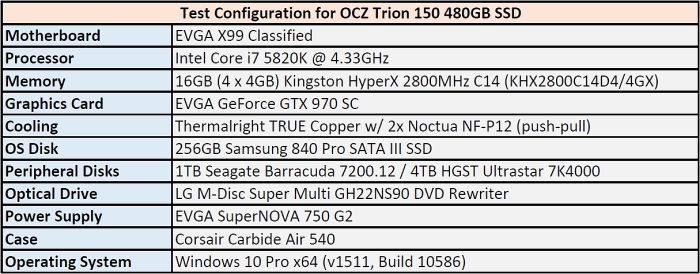
The system used for this test consists of an EVGA X99 Classified motherboard, Intel Core i7 5820K processor running at 4.33GHz, 16GB (4 x 4GB) of Kingston HyperX DDR4 2800MHz CL14 memory, an EVGA Geforce GTX 970 SC graphics card, a 256GB Samsung 840 Pro SATA III SSD for the OS disk, and Windows 10 Pro x64 (v1511, Build 10586) for the operating system.
We used four of the most common disk benchmarking programs available for this test – CrystalDiskMark x64 (v5.1.2), ATTO Disk Benchmark (v3.05), Iometer (v.1.1.0), and AS SSD Benchmark (v.1.8.5636.37293).

Additionally, we decided to test the Trion 150 480GB SSD in a PlayStation 4 against the default 500GB SATA II hard disk that ships with the console. Many gamers have often wondered if replacing a standard console hard disk with a more efficient solid state disk makes any difference in initial game loading and level loading times. Our game console test featured a standard PlayStation 4 (US version) console running PS4 System Software 3.15 and the 500GB HGST Travelstar Z5K500 SATA II 5400RPM hard drive. In total, we tested loading times in five games – Fallout 4 (2013), Super Time Force Ultra (2015), Tom Clancy’s Rainbow Six Siege (2015), Killzone: Shadow Fall (2013), and Mortal Combat X (2015).
The OCZ Trion 150 480GB was installed into the PlayStation 4 and initialized as a new OS disk with a fresh installation of PS4 System Software 3.15. The games were then installed from their respective PS4 Blu-ray game discs (except for Super Time Force Ultra, which was downloaded from the PlayStation Store).
CrystalDiskMark is a useful drive benchmarking utility that measures sequential read and write performance at various sizes and random read and write performance at various sizes. It allows users to gain a surface-level understanding of drive performance similar to those found on product retail packaging.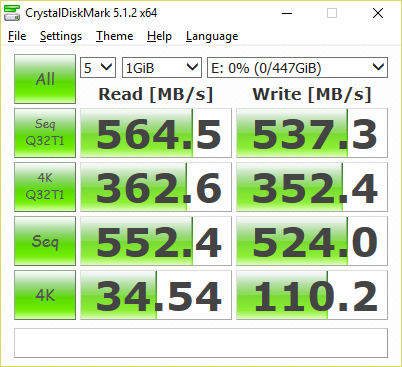
In the default 1GB random test, sequential read performance closely approaches the 600MB/s limitation of the SATA III interface, and both sequential read (564.5MB/s) and sequential write (537.3MB/s) performance actually surpass OCZ’s Trion 150 480GB product specs of 550MB/s reads and 530MB/s writes.
In the 1GB 0Fill test, all numbers are mostly the same as above with the exception of a noticeable ~113MB/s increase in 4K random read performance and a ~57MB/s increase in 4K random read performance at QD32.
ATTO Disk Benchmark is a bit more comprehensive and includes tests with predefined block sizes. This is useful for measuring performance across both small and large files and can produce more fine-tuned results. On the other hand, Iometer is also another comprehensive disk benchmark utility and allows users to stress random I/O performance in real-time using random 4KB files.
For this test, we ran the default 256MB transfer size benchmark from 512 bytes to 64MB.

Based on ATTO results, the OCZ Trion 150 480GB shows remarkably consistent transfer rates between 64KB and 64MB and is perhaps one of the more consistent drives we have seen thus far. The drive maxes out at 563MB/s read speeds and 536MB/s write speeds, both above OCZ’s rated product specs, and these results are very consistent with the ones we have seen from our colleagues.
Iometer is a more dated application that is still very relevant for measuring random I/O performance in real-time. The program was announced by Intel back in 1998 and was originally released during that year’s Intel Developer Forum. It is based on a client-server model and allows I/O monitoring by performing massive I/O operations and stressing the system hard. Default parameters are 4KB file size chunks, and this is what we are using to test 4KB sequential I/O read and write performance.
For this test, we decided to measure performance with OCZ’s default 6.25 percent over-provisioning and additional 20 percent over-provisioning, as sometimes it can prove useful for sequential 4KB performance.
Iometer (4KB, 100% read) – No added over-provisioning (default 6.25 percent)

The default 6.25 percent results show 143.8 total MB/s and 35,101 IOPS at 0.03 milliseconds average response time and 4.46 milliseconds maximum response time. CPU utilization on the Core i7 5820K is at 5.58 percent.
Iometer (4KB, 100% read) – 20 percent over-provisioning
The 20 percent over-provisioning results show 149.3 total MB/s and 36,456 IOPS at 0.03 milliseconds average response time and 0.74 milliseconds maximum response time. CPU utilization is also lower at 4.98 percent.
Finally, AS SSD Benchmark is a great utility to compare sequential and random read / write performance against CrystalDiskMark results.
Based on our results, the Trion 150 480GB gets a total score of 857, with a read score of 251 and a write score of 459.
Here, we are seeing 529MB/s sequential reads and 502MB/s sequential writes, whereas the CrystalDiskMark results showed 552MB/s sequential reads and 524MB/s sequential writes. AS SSD also shows 43MB/s random 4K reads and 88MB/s random 4K writes, whereas CrystalDiskMark showed 35MB/s random 4K reads and 110MB/s random 4K writes. There are definitely some programming differences between the two benchmark tests, but the results are still consistent within OCZ’s rated drive specifications.
PlayStation 4 Performance – OCZ Trion 150 480GB SSD vs. HGST Travelstar Z5K500 500GB HDD
Most reviews will only go to the extent of measuring drive performance within a standard PC environment. We decided to go against the status quo and attempt to answer what has long been a question for many gamers – whether replacing a console’s default hard disk drive (HDD) with a solid state disk (SSD) will net any performance benefit in game loading times and level loading times. Here are the results.
Fallout 4 (v1.03)
Fallout 4 is one of the most storage-intense games currently on PC and eighth-generation consoles. The game uses around 37GB on the PlayStation 4 and takes over 1 minute to load a save point with a conventional SATA II hard drive. With the Trion 150 480GB SSD, it takes less than 30 seconds. We have found actual game loading times to fluctuate between 15 and 20 seconds for both HDD and SSD, so we will consider them around the same for this review.
Super Time Force Ultra (v1.02)
Super Time Force Ultra is a side-scrolling action and shooter game where players have 30 lives to run through “bullet hell” levels. Players can choose from over 16 different characters across 6 different stages with a variety of weapons and powers exclusive to each one. For this test, we are showing identical game loading speeds on both the Trion 150 480GB SSD and HGST Travelstar 500GB HDD.
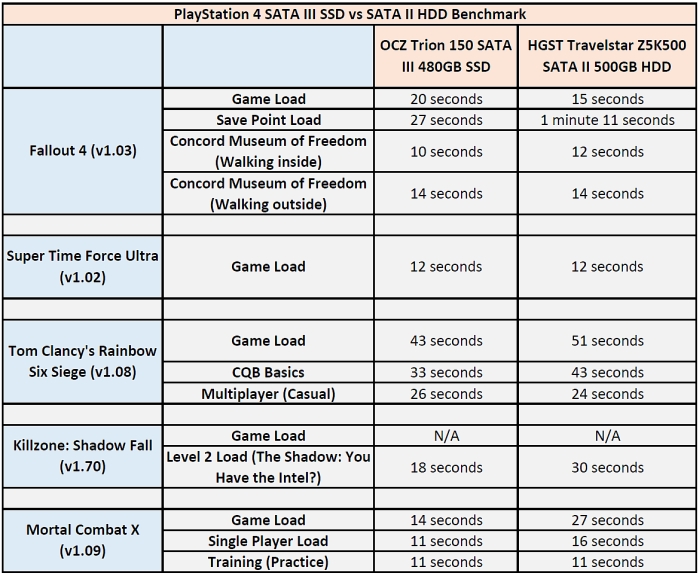
Tom Clancy’s Rainbow Six Siege (v1.08)
Rainbox Six Siege is the December 2015 installment in Tom Clancy’s Rainbow Six series, which first released in August 1998 and has now amassed more than 17 titles (not including the cancelled Rainbow 6: Patriots). In this tactical first-person shooter, players identify as an operator from the counter-terrorist Rainbow team unit and are not allowed to change operators during a round. When a round begins, attackers choose one of many spawn points from which to launch an attack, many of which feature a heavy emphasis on [procedural] environmental destruction. Over the course of the round, players gain tactical advantages through environmental destruction, and this ultimately gives allows them to be more creative in their gameplay strategies.
The PlayStation 4 version of the game installs just under 21GB and the game loads in just 43 seconds on the OCZ Trion 150 480GB compared to 51 seconds on the HGST Travelstar 500GB HDD. Load times for the CQB Basics level are down to just 33 seconds on the SSD compared to 43 seconds on the SSD, and casual multiplayer loading times are within 2 seconds between the SSD (26 seconds) and the HDD (24 seconds).
Killzone: Shadow Fall (v1.70)
Killzone: Shadow Fall (2013) is a PlayStation 4 launch title and was published Sony Computer Entertainment with development from Guerrilla Games. It is the sixth game in the science-fiction franchise and was made exclusively for Sony’s next-generation console.
The game installs at around 37GB on the PS4 before additional content packs and updates. Game loading times were not applicable for this test because it loads relatively quickly regardless of storage device. We decided to pick a more texture-heavy level for this performance test and ended up choosing Level 2 – The Shadow, in the Section titled, “You Have the Intel?” This particular checkpoint loads in just 18 seconds on the Trion 150 480GB SSD compared to 30 seconds on the HGST Travelstar 500GB HDD, and in a game with many checkpoints these loading times can add up quickly over the span of single player gameplay.
Mortal Combat X (v1.09)
Mortal Combat X (2015) is the tenth installment of the Mortal Combat video game series and was developed by NetherRealm Studios and published by Warner Bros. Interactive Entertainment. The console versions received mostly positive reviews from critics upon release, and it is available on PlayStation 4, Xbox One, PC, Android and iOS. The game is based on Unreal Engine 3 and installs at around 45GB on the PlayStation 4.
In this test, the game loads in 14 seconds on the OCZ Trion 150 480GB SSD compared to 27 seconds on the HGST Travelstar 500GB HDD that comes standard with the PlayStation 4. Single player load times also shave off a few seconds with the SSD (11 seconds) compared to the HDD (16 seconds), and Training (Practice) load times are identical on both drives.
For its “competitive overview” presentation slide, OCZ is comparing the Trion 150 series (15-nanometer TLC NAND flash) against its previous Trion 100 series (Advanced 19-nanometer TLC NAND flash), along with the SanDisk SSD Plus (Advanced 19-nanometer MLC NAND flash), the Crucial BX200 (16-nanometer MLC NAND flash), and the Kingston V300 (20-nanometer MLC NAND flash). Therefore, makes sense to compare any performance-per-dollar ratings with these particular drives in mind. We will be focusing particularly on 480GB capacity variants.

(OCZ Trion 150 competitive SSD overview. Larger image here.)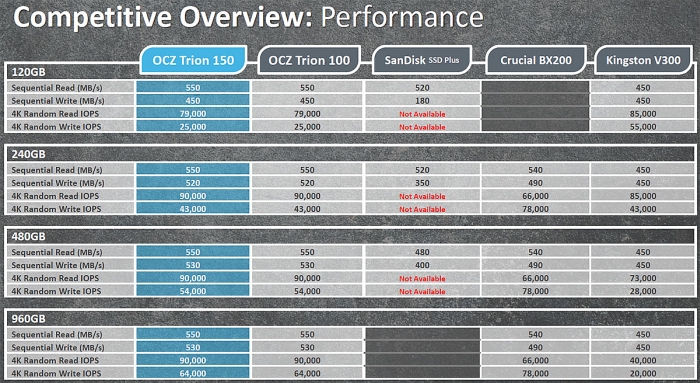
(OCZ Trion 150 competitive performance overview. Larger image here.)
The OCZ Trion 150 480GB is priced at just $117.49 ($0.24-per-gigabyte), making it the most affordable 480GB drive on the chart and probably one of the most affordable we have seen. By comparison, the OCZ Trion 100 480GB is now $99.99 ($0.21-per-gigabyte), so a good question now becomes whether an upgrade to 15-nanometer TLC NAND flash is worth an extra $17 dollars over its 19-nanometer predecessor.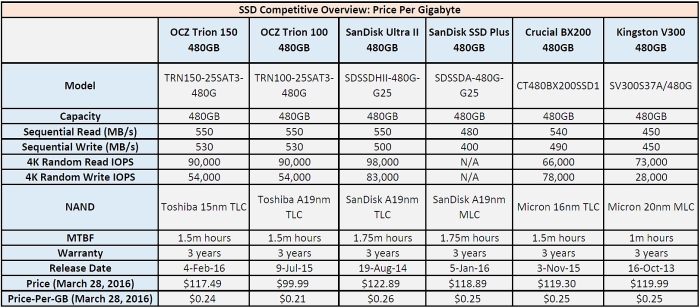
SSD Competitive Overview: Price-Per-Gigabyte as of March 28, 2016 (Larger image here.)
On the other hand, the SanDisk SSD Plus 480GB is now $118.89 ($0.25-per-gigabyte), roughly the same price as the Trion 150 480GB, but features much lower maximum sequential read and write performance.
OCZ did not include one of our favorite drives in its comparison chart, the SanDisk Ultra II, which is now $122.89 ($0.26-per-gigabyte). This drive is based on SanDisk’s second-generation 19nm 128Gbit TLC NAND flash and Marvell’s 88SS9189 eight-channel controller (480GB and 960GB models). The 480GB model comes with a 20GB “SLC-like” cache, called nCache 2.0, and features up to 550MB/s sequential reads, up to 500MB/s sequential writes, up to 98,000 IOPS random 4K reads and up to 80,000 IOPS random 4K writes. If we include SanDisk’s Ultra II 480GB into the lineup, it now becomes the fastest drive in terms of 4K random IOPS, surpassing the Trion 150 480GB by 8.16 percent more 4K random read performance and 35 percent more 4K random write performance.
SanDisk’s Ultra II drives also have several advanced flash management features including nCache 2.0, multi-page recovery, XOR recovery and “on chip copy,” which will copy “SLC-like” write blocks from non-volatile cache memory into TLC NAND flash.
Meanwhile, OCZ has a competing technology in its Vector, Trion 100 and Trion 150 SSD lineups called “Performance Mode” that uses about 1.5 percent of total TLC storage as “SLC-like” cache by writing only a single bit of data. This amounts to about 7.2GB of cache on the 480GB drive, or 14.5GB on the larger 960GB drive. As such, users who writing large datasets to solid state storage should consider using one of the larger capacity drives. Some reviews have shown that file size transfers above the 7.2GB cache size for the 480GB drive have almost doubled in speed over the Trion 100 simply due to the newer 15-nanometer TLC NAND flash. So if sustained large transfers are a big deal, then spending an extra $17 for the Trion 150 480GB over the Trion 100 480GB is definitely justified. However, we might still recommend using an MLC-based drive for sustained transfers with more file size variations, such as the OCZ Vector 180 480GB.
Conclusion – Fantastic sustained sequential performance, but 4K random IOPS could be higher
While the drive doesn’t look any different than its predecessor on paper except for newer 15-nanometer Toshiba TLC NAND flash, the OCZ Trion 150 has a hidden secret ingredient that the paper specifications will not show. We are talking about the drive’s surprising sustained read and write performance at both small and large file sizes. Based on our ATTO benchmark results, the Trion 150 480GB managed to maintain 554 to 562MB/s read speeds between 64KB and 64MB transfer sizes, and 518 to 533MB/s write speeds between 64KB and 64MB transfer sizes, making this drive one of the more efficient in the “sustainable sequential performance” category for both small and large raw data sets.
In the past, OCZ drives have been known for rather high failure rates, and this is even highlighted in a dedicated section on the company’s Wikipedia entry. However, since the acquisition by Toshiba in January 2014 and subsequent migration of product manufacturing into Toshiba’s own hands, average drive failure rate has dipped surprisingly below 1 percent. The drive’s Toshiba TC58 controller is the same one used in its Trion 100 predecessor, and according to OCZ reliability data released in August 2015, the overall return rate of the company’s storage solutions was only at 0.57 percent that year.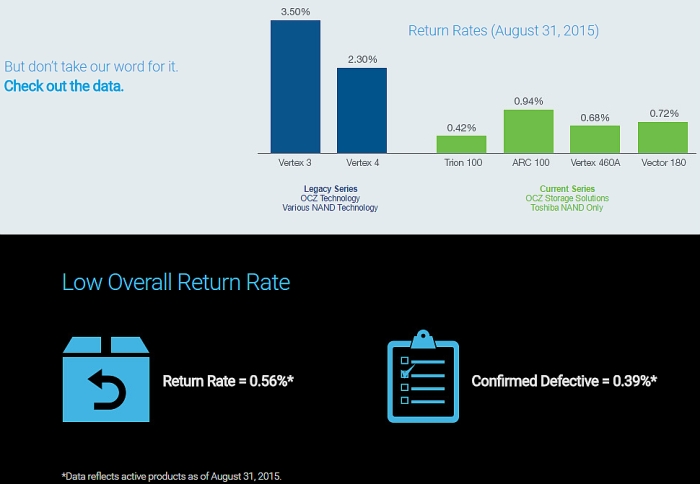
Last year, only 0.42 percent of Toshiba-based Trion 100 series drives were returned. Additionally, the company notes that only 0.31 of total manufactured drives are faulty, which is an excellent case in point that the transition to in-house technology has been a major factor in reducing product return rates and greatly improves the customer purchasing experience.
The OCZ Trion 150 480GB is available for $117.49, making it one of the most affordable 480GB drives on the market with 550MB/s sequential read performance that closely approaches the 600MB/s limit of the SATA III specification. In our tests, however, we found this drive topping out at 563MB/s read speeds and 536MB/s write speeds, both exceeding OCZ’s rated performance specs and highlighting its ability to easily outpace other TLC-based drives like the Crucial BX200 480GB.
If one is simply looking at this drive for the appeal of newer Toshiba 15-nanometer TLC NAND flash, however, prepare to be slightly disappointed. For just $5.40 more, the SanDisk Ultra II 480GB featuring SanDisk’s Advanced 19-nanometer TLC NAND still offers 8.16 percent more 4K random read performance (98,000 versus 90,000 IOPS) and 35 percent more 4K random write performance (83,000 versus 54,000 IOPS). In terms of IOPS, the drive still doesn’t come up to the top-tier TLC performance bracket where the Samsung 850 EVO 500GB (Samsung 128Gbit 40nm TLC V-NAND) is placed, but it does take a good shot at sustained sequential read and write performance, and in some cases, outperforms Samsung’s 3D-stacked TLC NAND offering.
Competitive Warranty
OCZ’s ShieldPlus warranty program is also an advantage to the Trion 150 series worth mentioning. In the past, customers have experienced unnecessary frustration over RMA handling times by customer service representatives from many well-known SSD manufacturers. It would traditionally take more than a week to return a defective unit and receive a replacement, during which time a user’s system would be out of commission or running with a less-than-ideal spare drive. With OCZ’s warranty program, a customer can simply provide their serial number to an OCZ customer service agent and if the drive is determined defective, a new replacement will be sent out immediately at no additional cost. This program is currently offered in North America and EMEA, and additional regions will be available in the future.
Final Word
At the end of the day, the OCZ Trion 150 480GB performs as expected for a drive with triple-level cell (TLC) and is at the top of the ranks for sustained sequential performance below $120. However, for just $5.40 more, the SanDisk Ultra II 480GB released back in August 2014 and based on A19nm TLC NAND still performs better in random 4K tests, so there is definitely a trade-off in terms of how a user intends to do with this drive. If the drive will be used for highly random workloads with large datasets above 7.5GB (the point where integrated “SLC-like” cache runs out of room and switches to TLC NAND storage), then it might be a better option to avoid more cost-friendly options and go with an MLC-based drive like the Samsung 850 Pro 512GB ($217.97) or OCZ Vector 150 480GB ($169.99).
However, if the drive will be used for large file transfers below 7.5GB, like moving ISO files and loading texture-rich game levels, then the Trion 150 480GB is the drive to beat for a majority of consumers.




